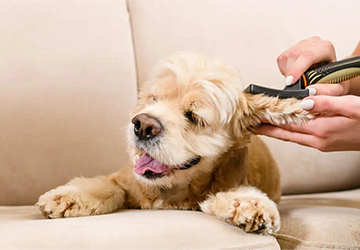Do you dread grooming time with your furry friend? Does bath time often become a wet, wild rodeo that leaves you both stressed and soaked?
You're not alone if your pet hates brushing, nail cliyou's or baths. Many pet parents need help with uncooperative pups and cats regarding grooming.
But what if grooming could be a bonding experience you both enjoy? A relaxing spa session of gentle massages and pampering? It may sound too good to be accurate, but with some patience and the proper training, you can have a well-groomed pet that loves curling up for brushings.
In this blog post, we'll share six simple tips to transform even the wildest pet into a model citizen at the grooming salon. These positive reinforcement-based training methods can help improve behaviour from tiny kittens to elderly arthritic dogs.
Say goodbye to wrestling matches and tears at grooming time, and get ready for cuddly spa days ahead!

6 Tips for Better Pet Grooming Training
We know grooming can be a challenge with pets. But with the right approach, you can set your pet up for grooming success. Here are six tips to help train your pet for better behaviour during grooming sessions:
1.Start Them Young with Positive Handling
Early, gentle handling goes a long way toward setting grooming success. As soon as you bring home that bubbly bundle of fur, start instilling positive associations.
Gently touch paws, ears, tail, and more, offering treats and affection. Rub with a soft brush while feeding treats. Handle nails briefly while praising. These short, sweet sessions build confidence in handling.
2.Take It Slow and Give Them Control
Rome wasn't built in a day, and great grooming habits start small, too. Keep initial sessions just 30 seconds or a minute, letting your pet sniff tools first. Allow them to choose to engage, rewarding them with treats when they do.
Let them walk away to end sessions. As tolerance builds over multiple days, gradually ask for more duration before offering a break. This sense of control and patience prevents flooding them.
3.Shower Them with Tons of Tasty Treats
Treats and praise should flow freely during grooming like water at a fountain! Use tiny, soft, irresistible bits to keep motivation high—prompt desired behaviour with treats before rewarding cooperation.
Pair treats with cheerful praise and petting to build very positive associations. This taps into the power of conditioning to link rewards with grooming.
4.Invest in the Right Tools
Quality tools designed for comfort and safety remove obstacles during training. Rubber-tipped nail grinders are less scary than clippers. Specific brushes glide through tangled coats better.
Elevated bathtubs reduce joint strain. Be sure to introduce new tools slowly, too. Offering choices between types of brushes or bath locations also builds their confidence.

5.Keep Sessions Short, Sweet, and Frequent
Daily or weekly short positive sessions trump wrestling your pet every few months. As part of your routine, brief, gentle handling prevents matting, overgrown nails, and dirty coats. It also continues reinforcing the behaviour.
Long gaps between negative grooming experiences undo all your hard work. A few minutes several times a week maintains steady progress.
6.Most Importantly - Remain Calm and Patient!
Finally, mindset is critical during the training process. Approaching sessions with a relaxed, positive state of mind sets everyone up for success. If your pet squirms or resists, stay composed.
Speak in a soothing tone, redirect to an easier task, and then try again later. Progress won't be linear. But with consistency, patience and praise, you'll both start enjoying grooming sessions in no time.
Conclusion
Grooming is essential to caring for your beloved pet's health and happiness. But if your fur baby dreads clipping nails or detangling fur, it makes an unpleasant chore for both of you.
Following these tips can help train your pet to tolerate and cooperate better for grooming.
While it takes some time upfront, the payoff of stress-free grooming sessions for years is worth it. So be patient, be kind, and set your pet up for success.
FAQs
Q: How old should my pet be when I start grooming training?
Ans: Start gentle handling and treats when bringing a new puppy or kitten home. This allows them to become comfortable with grooming touch during formative early weeks. Formal training can begin around 4-6 months old.
Q: What treats work best for training?
Ans: Small soft treats like tiny meat bits or cheese are ideal so you can give frequent rewards. The key is a small size so as not to fill your pet up fast, palatability to keep them motivated, and softness to be easily chewable in seconds.